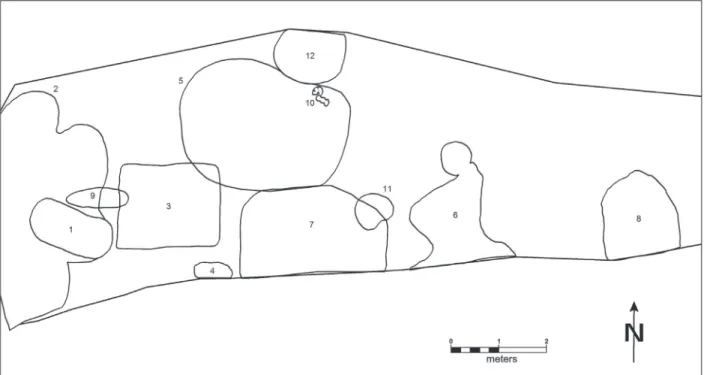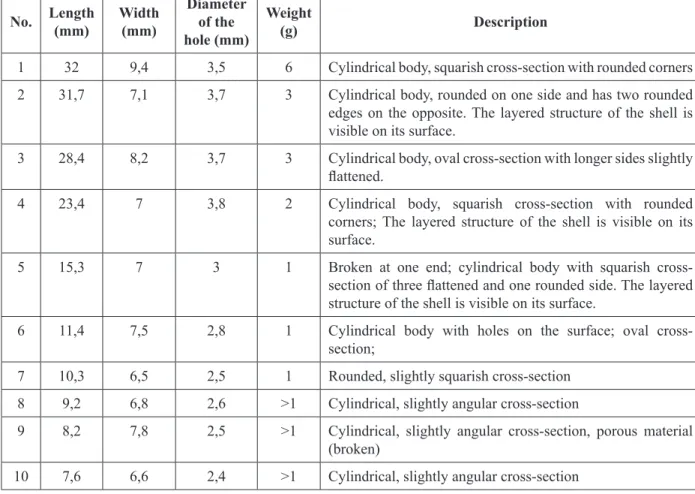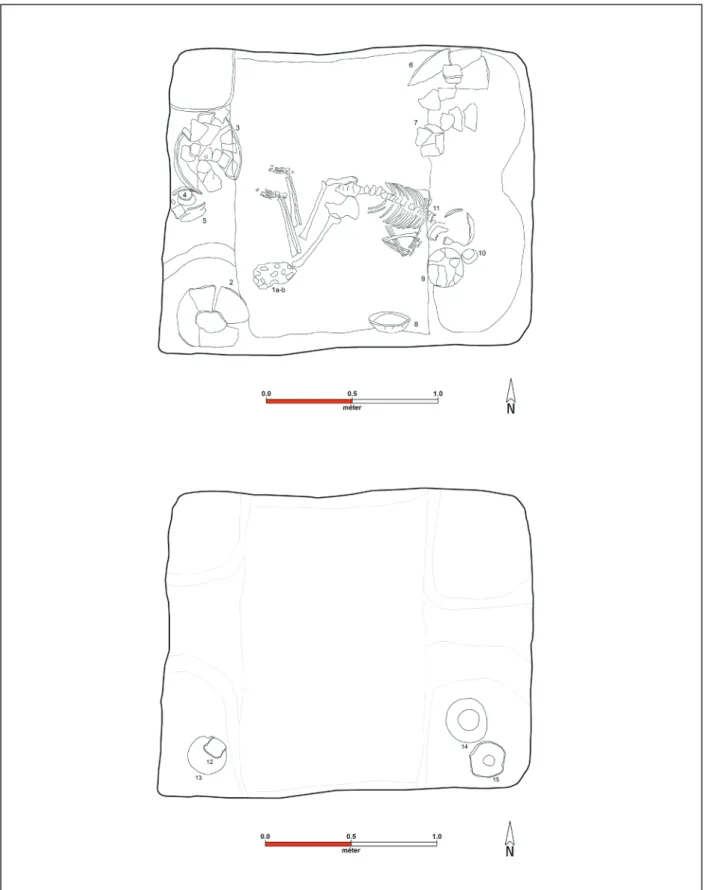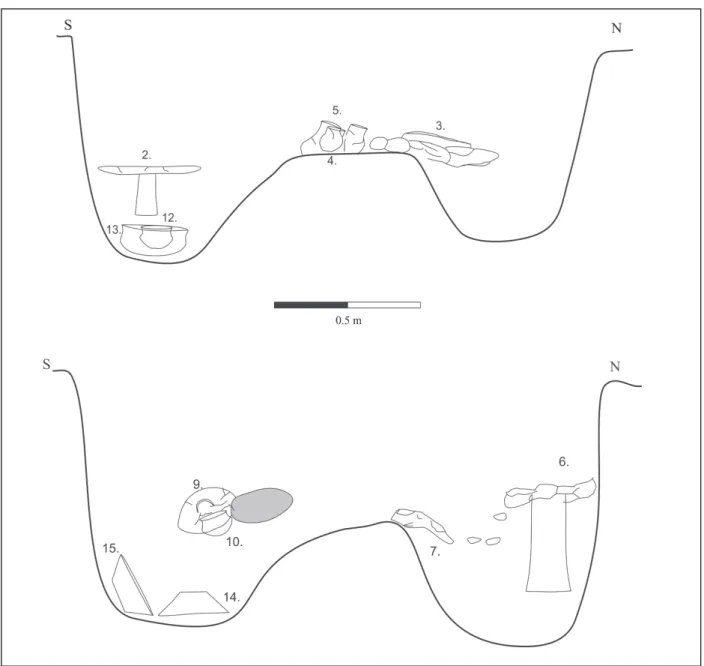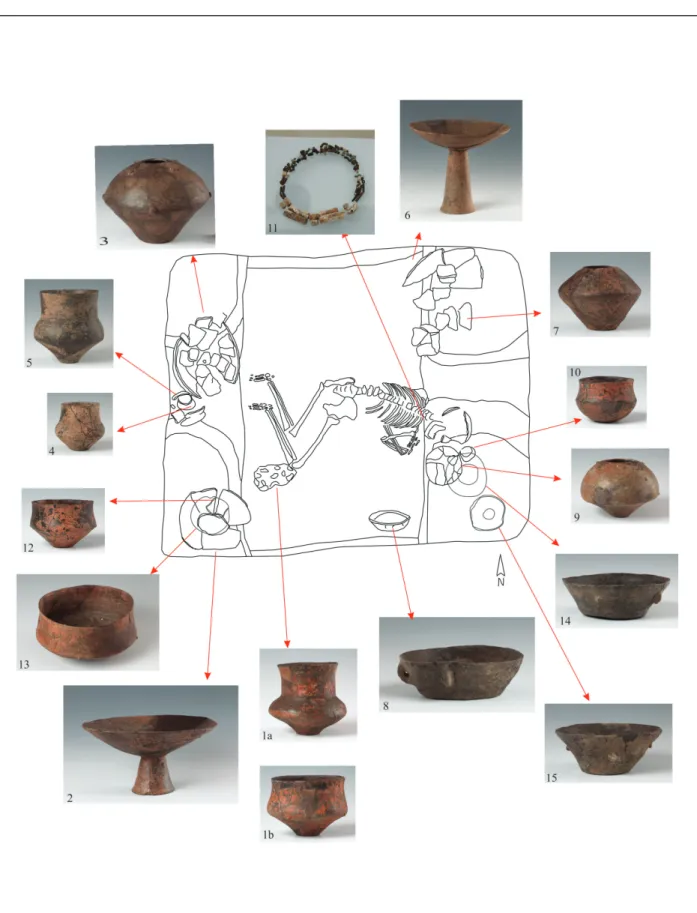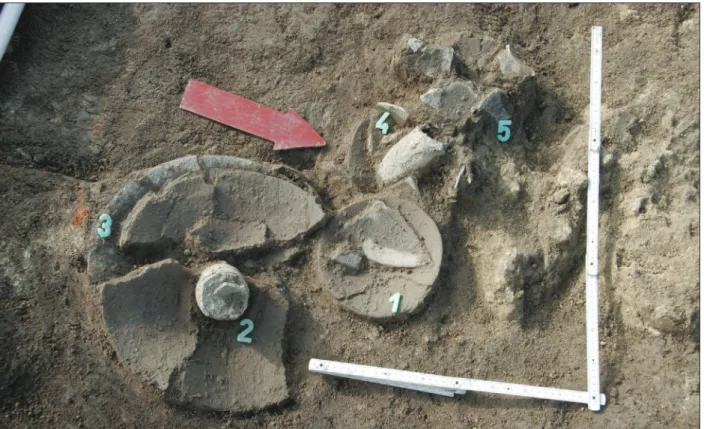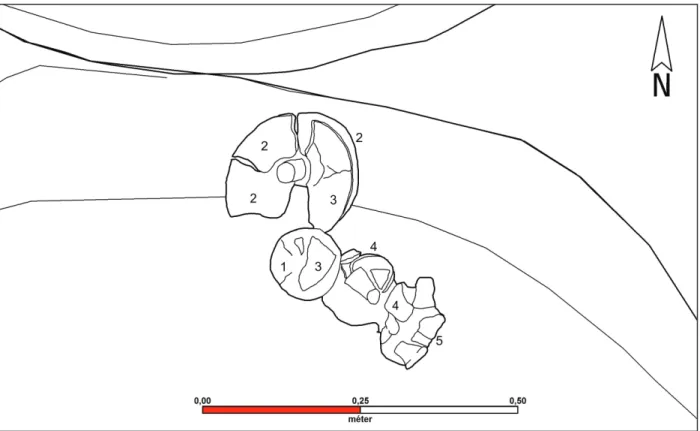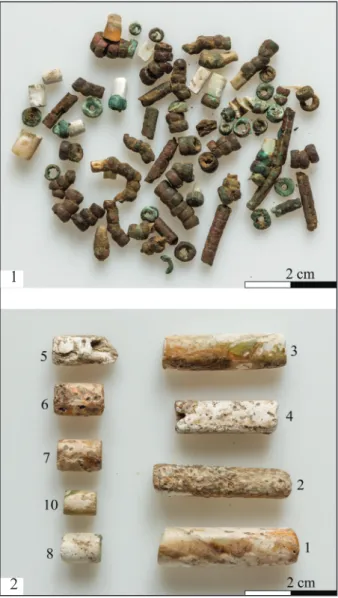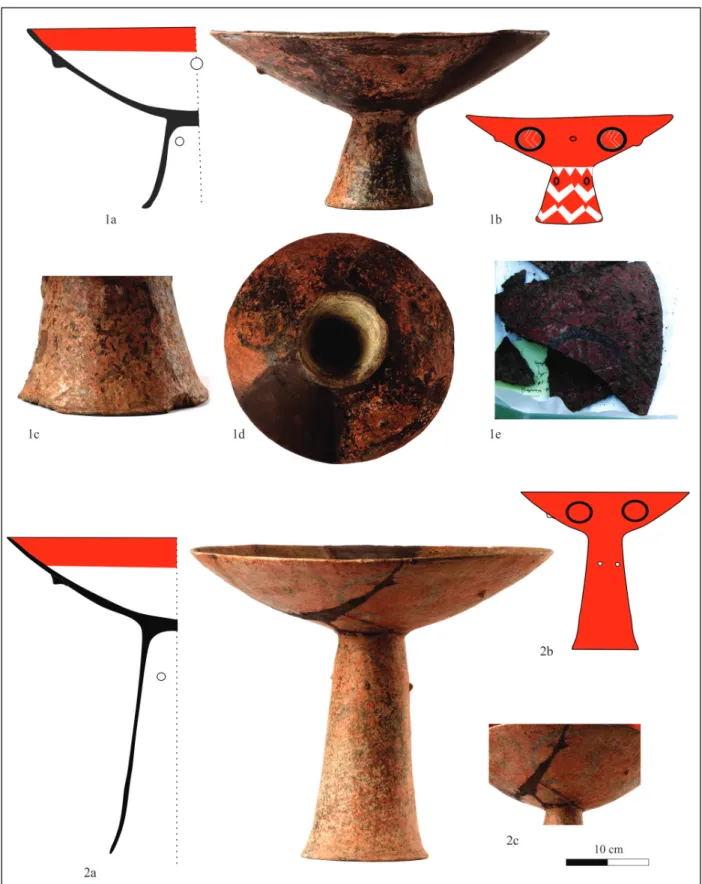45 The “Lady of Borjád”
Csilla Gáti–Gábor Bertók
The Grave of The “Lady of Borjád” – a LaTe NeoLiThiC WomaN of hiGh STaTuS from BaraNya CouNTy (huNGary)
The paper publishes a recently excavated grave and the possible remains of an adjacent, but destroyed grave, both dated to the Late Neolithic Lengyel Culture. The graves were found in 2010 during a rescue excavation near the village of Borjád (Baranya County, southwestern Hungary). The intact grave (and most probably the destroyed one, too) belongs to a recently discovered type of high-status burial within a large rectangular burial pit with hollowed corners. Many of these graves are richly endowed with grave goods.
Though hundreds of Lengyel Culture graves have been published so far from Baranya, the intact Borjád grave is the first of the type from the county, and second outside the site (Alsónyék-Bátaszék, Tolna County) where the type was discovered.
A cikk két, egy ép és egy nagyrészt elpusztult, a késő neolitikus lengyeli kultúra idejére keltezhető sírt mutat be. A 2010-ben, a Baranya megyei Borjád határában egy mentőásatás keretében feltárt objektumok abba a nemrég azonosított típusba sorolhatók, melyeknek fő jellemzője a nagy, téglalap alakú sírgödör, melynek sarkaiba mélyedéseket vájtak. E sírok egy jelentős részére jellemző még a gazdag sírmelléklet is. Noha Baranya megyéből már több száz publikált lengyeli sírt ismerünk, az itt ismertetett típus eddig ismeretlen volt, és a baranyai sír a második, amely a típust ismertté tevő alsónyék-bátaszéki lelőhelyen kívül előkerült.
Keywords: Lengyel Culture, high-status grave, burial structure, copper, marine shell, necklace, strainer Kulcsszavak: lengyeli kultúra, fejedelmi temetkezés, sírépítmény, réz, kagyló, nyaklánc, szűrőedény in the autumn of 2010, a local amateur archaeolo-
gist donated a more-or-less intact pedestalled vessel to the department of archaeology of the janus Pan- nonius museum, Pécs. he reported that the vessel and some other sherds were washed out by a tem- porary watercourse in the vicinity of the village of Borjád (fig. 1).1 The vessel can be dated to the Late Neolithic Lengyel Culture because of its character- istic shape and porous red paint.
after this kind donation, we visited the site with the local representative of National Office of Cul- tural heritage. The area is cultivated as a nursery garden. field-walking of ca. 2 ha area around the findspot of the pedestalled vessel produced finds belonging to the Lengyel Culture indicating that a settlement was located there.
We found that the vessels were brought to light by excess irrigation water that had repeatedly flowed through the area. Since this process endangered a part of the site, we implemented a small-scale res- cue excavation that produced unexpected results.
following the removal of the thin layer of top- soil, we found the traces of several scattered over- lapping features belonging to the middle and Late Neolithic periods (fig. 2). in general, the features of lighter brown fill proved to be those containing middle Neolithic material. Because of the small size of the excavation area, most of the larger features could not be fully excavated. a pale, but unusually rectangular, discolouration (feature 3) stood out of the exposed features, most of which were irregu- larly shaped. as it turned out later, this feature was a rich grave.
apart from the various pits and the aforemen- tioned grave, we also uncovered the possible re- mains of another destroyed grave (feature 10) that was dug into a previously back-filled pit complex (feature 5).
it seems therefore that the site was inhabited during at least two periods of the Neolithic. in sev- eral cases, the pits of the Lengyel Culture cut those that belonged to the middle Neolithic. in turn, the
2015–2016
Lengyel graves were cutting other Lengyel Culture features. This fact also suggests at least two hori- zons during the Lengyel Culture period of the site;
most probably the graves indicate a period when the excavated part of the settlement was not in use any- more. in our paper, we present only the graves.
Description of the graves Feature 3 (Fig. 3–9)
having removed the topsoil, feature 3 showed up as a rectangular discolouration that seemingly cut feature 5, a pit of the Lengyel Culture. Surmis- ing that the pit might be analogous with the then mostly unpublished alsónyék-Bátaszék ‘Haupt- lingsgräber’, we began to remove the backfill from half of the pit in order to produce a verti- cal section but after the removal of a mere 25 cm of the more-or-less homogenous fill, we already found human bones and pottery.
accordingly, we continued to uncover the remains, and found a contracted skeleton lying on its left side in an east-west orientation. The bones were preserved in bad condition, and parts of the crushed skull were missing, most probably removed by a burrowing animal. along the east and west wall of the pit, we found two trench- like elongated hollows that contained the major-
ity of the grave goods. in the corners of the pit, the ends of the “trenches” were further deepened forming four posthole-like cavities. The skeleton was positioned on the central “plateau”, slight- ly south of the west-east axis of the rectangular grave. The head extended beyond the central floor of the grave and, as we found it, lay inclined on the slope of the east trench. it seems though that originally the head had been supported by some- thing made of perishable material, e.g., a wooden burial bed or a pillow that decayed over time, thus causing the head to descend onto the steep slope below it (fig. 5).
The grave measured 175×210 cm. The original depth of the grave cannot be determined because of the erosion of the slope. measured from the present-day surface, the deepest points in the cor- ners were -70–75 cm while the main floor was at a relative depth of 40 cm.
The grave goods consisted of 15 ceramic ves- sels and a necklace comprising beads made main- ly of copper and marine shells. most of the ves- sels were placed in the hollows in the corners.
however, three pieces lay on the shallower, cen- tral part of the west trench and three pieces were placed on the central floor. One of these latter two vessels was adjacent to and leaning on the south wall ca. 10 cm higher than the skeleton, and two fig. 1 Location of the site in hungary
1.kép A lelőhely elhelyezkedése
47 The “Lady of Borjád”
other vessels lay near the knee of the body. four vessels were found on a second level: below the level of the skeleton, in the southeast and south- west “posthole”, below other vessels (fig. 7–8).
Grave goods
Nr. 3/1a. Beaker (o.2012.305.3.1; fig. 14, 1). Well- fired, finely tempered thin-walled, dark grey tripartite beaker. it has been restored to its full original form.
form: cylindrical neck, convex upper body, strongly conic, straight-walled lower body, small base. The en- tire outside of the vessel shows traces of red paint, as well as a painted strip on the inside right above the lip.
height: 9.5 cm, diameter of the rim: 8.5 cm, diameter of the bottom: 3 cm. found next to the knees of the skeleton. its pieces were found broken and mixed with the sherds of vessel 3/1b, so much so that the two sepa- rate vessels were only identified during the restoration process.
Nr. 3/1b. Beaker (o.2012.305.3.16; fig. 14, 2).
Well-fired, thin-walled, finely tempered, dark grey bi- conical beaker with traces of red paint on its outside and the inside below the rim. restored from sherds. it has a slightly curved neck, sharp carination, and conical lower body. it has four, evenly distributed knobs around its belly. height: 9 cm, diameter of the rim: 11.4 cm, diameter of the base: 3.5 cm. The sherds of this vessel
were mixed with those of vessel 3/1a and were sepa- rated and identified during the restoration work.
Nr. 3/2. Pedestalled vessel (o.2012.305.3.2; fig.
13, 1a–e). Well-fired, dark grey, low-pedestalled vessel.
The upper part of the vessel is conical with a straight profile. The rim of the pedestal is slightly flared. The vessel shows traces of red paint both on the inside and the outside. on the outside of the upper part there are four round knobs. in the areas between the round knobs the red paint is interrupted by four ring-shaped, unpaint- ed areas rimmed with white in the inner part. The red- painted inside of rings had white zigzag motifs painted on them. unfortunately, we have only photographs of the white motifs, because the white paint disintegrated shortly after the removal of the vessel from the soil.
four, evenly placed knobs are placed on the upper part of the pedestal. it seems that the pedestal was decorated with alternating red, white and unpainted, dark gray areas. unfortunately, only the traces of an unpainted saw-tooth pattern and a white, triangular shape painted on the red ground coat can still be discerned from the decoration of the pedestal. height: 21.5 cm, diameter of the rim: 41 cm, diameter of the base 12.5 cm. This ves- sel was found in the southwest corner of the grave. The rim of the vessel was on the same level as the central floor of the grave.
Nr. 3/3. Butmir type (mushroom) pot (o.2012.305.3.3;
Fig. 15, 7). Finely tempered, well-fired, dark grey pot with fig. 2 Plan of the excavated features
2. kép a feltárt jelenségek alaprajza
white, ‘basket-weave’ pattern on the partially surviving red base coat paint. There is red paint also on the inside of the neck. height: 10 cm, diameter of the rim: 8 cm, diameter of the base: 4 cm. it was found placed inside vessel 3/5, next to the pot 3/3.
Nr. 3/5. Biconical jar (o.2012.305.3.5; fig. 14, 6a–b).
Well-fired, thin-walled, finely tempered, dark grey tri- partite jar with cylindrical neck and biconical belly. its outside bears traces of red paint. Both the belly and the neck are decorated with four small knobs. restored from sherds. height: 18,7 cm, diameter of the rim: 15,5 cm, diameter of the base: 5 cm. it was found placed next to vessel 3/3.
Nr. 3/6. Pedestalled vessel (o.2012.305.3.6; fig. 13, 2a–c). Well-fired, finely tempered, dark grey pedestalled vessel. The upper part of the vessel is conical with slightly convex profile. The rim of the hollow pedestal is flared.
The outside and a 6 cm wide outer section of the inside of the vessel have traces of red ground paint. There is a single knob on the outside of the bowl, and another four knobs placed symmetrically around the upper part of the pedes- tal. There are four negative, dark grey ring motifs (12 cm in diameter, 1.5 cm in width) on the outside of the bowl.
height: 35 cm, diameter of the rim: 43 cm, diameter of the bowl: 15.5 cm. it was found in the northeast “posthole” of the grave.
Nr. 3/7. Butmir type (mushroom) pot (o.2012.305.3.7;
Fig. 15, 5). Small, thin-walled, well-fired, finely tempered, dark grey Butmir type (mushroom) pot with inward lean- ing, conical shoulder, and conical belly. restored from sherds. There are traces of red paint all over its outer sur- face. There is a single knob under its rim, and a possible one placed symmetrically on the opposing side. height:
13 cm, diameter of the rim: 6.5 cm, diameter of the base:
6 cm. found next to the vessel 3/6, in the northeast corner.
Nr. 3/8. Conical bowl (o.2012.305.3.8; fig. 15, 4).
Well-fired, oval, conical bowl. Restored from sherds. Tem- pered with fine gravel, its brownish-grey fabric is medium coarse. on one of its shorter sides there is semi-circular, vertical handle with a round hole. There are two vertical,
4 cm. it was found immediately in front of the skull, next to vessel 3/10, and overlying vessel 3/14.
Nr. 3/10. Beaker (o.2012.305.3.10; fig. 14, 3). Thin walled, finely tempered, well-fired dark grey beaker with flaring rim and sharp carination. There are traces of red paint all over its outer surface, and also around the rim on the inside. height: 6.5 cm, diameter of the rim: 9.5 cm, main diameter of the base: 2.8 cm. it lay next to vessel 3/9, in front of the forehead of the skull.
Nr. 3/11. Necklace (o.2012.305.3.11; fig. 12 a–b).
Necklace consisting of marine shell (Table 1), copper, and possibly bone and stone beads. The deceased wore a neck- lace consisting of copper, marine shell, stone, and possi- bly bone/tooth beads. The necklace was arranged in a way that the larger shell beads were at the back, and the copper beads in the front of the skeleton. The 126 copper beads of the necklace were probably formed by cutting and bend- ing copper wire. according to their size, they belong to three groups: 66 of them are made of bent wire and are ca.
3.5 mm in width, 56 pieces, also of bent wire, are ca. 4.5 mm in width, while 4 of the items were 1.4–1.5 cm long, thin tubes probably made of bent copper sheet. The over- all weight of the copper beads is 13 g. The larger marine shell beads are of various size ranging from 6.5 mm to 9.4 mm of width and 7.6 mm to 32 mm of length (Table 1).
among the copper beads there were 9 other very small, white beads probably made either of marine shell or bone.
The necklace also included 4 malachite beads similar to the larger copper beads in size, and a yellow, transparent, slightly triangular stone bead, all of them drilled through.
it was around the neck of the skeleton.
Nr. 3/12. Beaker (o.2012.305.3.12; fig. 14, 5a–c).
Thin-walled, finely tempered, well-fired, dark grey, bea- ker. restored from sherds, amended. it has slightly curved neck, sharp carination, and conical lower body. There are four evenly placed knobs along the carination. There are traces of red ground paint all over its outer surface, and also around the rim on the inside. unpainted lozenge pat- tern can be observed against the red base paint around the knobs decorating the belly of the beaker. The lozenges
49 The “Lady of Borjád”
are connected by diagonal lines on the bottom part of the body. faint traces of white ‘basket-weave’ motif could also be observed around its neck. The surface of the ves- sel below the paint is burnished. height: 7.8 cm, diameter of the rim: 11 cm, diameter of the base: 3.5 cm. it was found placed inside vessel 3/13, in the southwest corner, below vessel 3/2.
Nr. 3/13. Strainer vessel (o.2012.305.3.13; fig. 15, 1a–b). Thin-walled, well-fired, finely tempered brown- ish-grey bowl with slightly narrowing shoulder and gen- tly flaring rim. There are 25 holes, 3–4 mm in diameter, pierced through its body and base. Both its inside and outside has traces of red ground coat. There are four small knobs along the rim and also around the carina- tion. unpainted, inter-connected negative, semi-circular linear motifs surround the knobs on the carination line from below. height: 12.9 cm, diameter of the rim: 23 cm, diameter of the base: 6 cm. it was found under vessel 3/2 (pedestalled vessel) and contained 3/12.
Nr. 3/14. Conical bowl (o.2012.305.3.14; fig. 15, 2). Conical bowl of dark grey fabric tempered with fine
gravel, well-fired. Four large knobs distributed evenly around its side. Two of the opposing knobs are round the other two are vertically elongated. height: 7.5 cm, di- ameter of the rim: 23 cm, diameter of the base: 13.5 cm.
it was found placed upside down on the bottom of the hollow in the southeast corner of the grave. We found a bone fragment under it. items 3/9 and 3/10 were placed on top of this vessel.
Nr. 3/15. Conical bowl (o.2012.305.3.15, fig. 15, 6).
Conical bowl of medium coarse, brownish-grey fabric, tempered with fine gravel, well-fired. Status: restored from sherds, missing parts are amended. it has four, evenly distributed conical knobs on the midline of its body. height: 9.5 cm, diameter of the rim: 24.5 cm, di- ameter of the base: 11 cm. Next to the bowl 3/14, in the southeast hollow, at the bottom.
Feature 10 (Fig. 10–11)
Near the area most eroded by the occasional flow of excess water, we found several ceramic ves- sels, some placed on top of, and others next to, each Table 1 marine shell beads of the necklace (fig. 12, 2)
1. táblázat a nyaklánc tengeri kagylóból készült gyöngyei (fig. 12, 2) No. Length (mm) Width
(mm)
Diameter of the hole (mm)
Weight
(g) Description
1 32 9,4 3,5 6 Cylindrical body, squarish cross-section with rounded corners 2 31,7 7,1 3,7 3 Cylindrical body, rounded on one side and has two rounded
edges on the opposite. The layered structure of the shell is visible on its surface.
3 28,4 8,2 3,7 3 Cylindrical body, oval cross-section with longer sides slightly flattened.
4 23,4 7 3,8 2 Cylindrical body, squarish cross-section with rounded
corners; The layered structure of the shell is visible on its surface.
5 15,3 7 3 1 Broken at one end; cylindrical body with squarish cross-
section of three flattened and one rounded side. The layered structure of the shell is visible on its surface.
6 11,4 7,5 2,8 1 Cylindrical body with holes on the surface; oval cross-
section;
7 10,3 6,5 2,5 1 rounded, slightly squarish cross-section
8 9,2 6,8 2,6 >1 Cylindrical, slightly angular cross-section
9 8,2 7,8 2,5 >1 Cylindrical, slightly angular cross-section, porous material (broken)
10 7,6 6,6 2,4 >1 Cylindrical, slightly angular cross-section
other. We also found a cranial fragment among the sherds. The pottery assemblage (feature 10) was found buried in the uppermost layer of feature 5 (also a Lengyel Culture pit).
The fill of the pit most probably associated with the ceramic assemblage could not be differentiated from the surrounding dark back-fill of a pit. How- ever, the assemblage consisting of two, almost in- tact pedestalled vessels placed on top of each other, and six other vessels placed under and next to them reminded us very much of the grave goods placed in the corners of feature 3. it seems plausible that the rest of the putative grave had been destroyed by agricultural activity and erosion. according to mr. Kurucz, he had found the pedestalled vessel he kindly gave to the museum washed out immediately next to the spot where the assemblage of feature 10 was found. This fact further corroborates our sup- position that feature 10 had been a grave similar to feature 3.
Finds of Feature 10
Nr. 10/1. Pedestalled vessel (o.2012.305.10.1; fig. 17, 1). Well-fired, finely tempered, buff-coloured, small ped- estalled vessel with no traces of paint. The upper part has a straight profile, the base of the pedestal is slightly flared.
height: 15.7 cm, diameter of the rim: 18.7 cm, diameter of the base: 8.6 cm. found next to vessel 10/2 and 10/3.
Nr. 10/2. Pedestalled vessel (o.2012.305.10.2; fig. 16, 1a–c). Well-fired, dark grey, thin-walled, finely tempered pedestalled vessel. The bowl has a straight profile. Re- stored from fragments. Both the inside and the outside of the vessel has traces of red paint. There is a single knob on the outside of the upper part, and four evenly placed knobs on the upper part of the pedestal. There are four unpainted (black), circular motifs on the outside of the upper part with ring has black zigzag motifs on the inside. height:
25 cm, diameter of the rim: 24,5 cm, diameter of the base:
10.7 cm. its pedestal standing on top of 10/2, the sherds of its body were found broken off the pedestal and lying on vessel 10/3.
fig. 3 Photo of grave No. 3.
3. kép a 3. sír fényképe fig. 4 in situ photo of the necklace in grave 3.
4. kép in situ kép a 3. sír nyakláncáról
fig. 5 detailed photo of the upper head-part in feature 3
5. kép Részletfotó a fej környékéről a 3. jelenségben fig. 6 The empty grave No. 3 6. kép a 3. sír üresen
51 The “Lady of Borjád”
Fig. 7 Plan of grave No. 3 with grave goods on various levels: first level (above) and second level (below) 7. kép A 3. sír alaprajza a különböző szinteken elhelyezett mellékletekkel: első szint (fent) és második szint (alul)
Nr. 10/3. Pedestalled vessel (o.2012.305.10.3; fig. 16, 2a–c). Well-fired, finely tempered, dark grey pedestalled vessel. The bowl has a straight profile. The base is slightly flaring. There are traces of red paint on the outside of the vessel and also around the inside of the rim. There are four small knobs placed in equal distance around the body, and also around the upper part of the pedestal. There unpainted (black) ring motifs, 12 cm in diameter, between the knobs on the body. height: 28.8 cm, diameter of the rim: 35.5 cm, diameter of the base: 14 cm.
Nr. 10/4. Bowl (o.2012.305.10.4). Sherds of a thin walled, dark grey, red painted bowl, one piece with knob.
Nr. 10/5. Conical bowl (o.2012.305.10.5; fig. 17, 3).
Well-fired, dark grey conical bowl of semi-coarse fabric.
restored from sherds. height: 8.5 cm, diameter of the rim:
28 cm, diameter of the base: 12 cm. in the photos this vessel was marked 4 and 5. The sherds turned out to be parts of the same vessel during restoration. No. 10/4 was subsequently reassigned to o.2012.305.10.4.
Nr. 10/6. Butmir type (mushroom) pot (o.2012.
305.10.6; Fig. 17, 2). Well-fired, finely tempered, small, dark grey, thin-walled Butmir type (mushroom) pot with inward leaning, hemispherical shoulder, and conical belly.
it has four symmetrically placed knobs both below its rim fig. 8 North–south section drawings of grave No. 3: on the western side (above) and eastern side (below)
8. kép a 3. sír észak–dél irányú metszete: nyugati oldalon (fent) és keleti oldalon (lent)
53 The “Lady of Borjád”
fig. 9 Plan of grave No. 3. with restored vessels 9. kép a 3. sír alaprajza a restaurált edényekkel
and around its belly. it shows traces of red paint on the outside. height: 15.5 cm, diameter of the rim: 7.2 cm, di- ameter of the base: 5.5 cm. its sherds were found during the removal of upper vessels of the assemblage.
Nr. 10/7. Beaker (o.2012.305.10.7, fig. 17, 5a–c).
Status: restored from sherds. it has four symmetrically placed knobs both below its rim and around its belly.
There are negative, dark spiral motifs around the knobs on its belly. Traces of white –“basket-weave” motifs on red ground coat can be seen on its neck. height: 10.8 cm, diameter of the rim: 16 cm, diameter of the base: 5 cm.
found under vessel 10/3.
Nr. 10/8. Beaker (o.2012.305.10.8; fig. 17, 4). Thin walled, well-fired, finely tempered, dark grey beaker.
Status: restored from sherds. it has two symmetrically placed knobs both below its rim and on its belly. The beaker shows no traces of paint. its outer surface is bur- nished. height: 8.5 cm, diameter of the rim: 8.3 cm, di- ameter of the base: 5 cm. found under vessel 10/1.
Nr. 10/9. Sherds of a vessel with linear traces caused by the process of forming (o.2012.305.10.9).
Nr. 10/10. Sherds of a biconical vessel (belly and knob) (o.2012.305.10.10).
Analysis Grave structure
Lengyel graves resembling feature 3 in its rect- angular shape with side trenches and “postholes”
in the corners have not been known until very re- cently. So far, they have been found at only one site in the neighbouring Tolna county (Gallina et al. 2010; Zalai-Gaál–OsZtás 2009; Zalai-Gaál– OsZtás–Köhler 2012). of the 1,593 analyzed graves of the ca. 2,300 burials dated to the period of the Lengyel Culture at the alsónyék-Bátaszék site (Tolna County) 123 burials (7.72 per cent) be- longed to this type (Zalai-Gaál–OsZtás–Köhler 2012, 72). The common characteristics of the rect- angular, “side trench and posthole” type are: 1.: a near-rectangular shape, 2.: large size when com- pared to ‘ordinary’ burials (1.6–2.5 m length), 3.: a deep trench and/or posthole-like hollows inserted into the sides and/or corners of the grave cut.
Burial rite2
according to the anthropological analysis (for the details see the appendix), the person buried in fea- ture 3 was an adult female. according to the analy- fig. 10 Photo of the possible grave No. 10
10. kép a 10., feltételezett sír fényképe
55 The “Lady of Borjád”
ses dealing with the Late Neolithic burials in the surrounding region, the majority of the graves were those of adult women (Zalai-Gaál 2010, 52–53).
however, in the case of the graves similar in struc- ture to feature 3, the ratio of the two sexes is more or less equal (Zalai-Gaál–OsZtás–Köhler 2012, 112).
The contracted body lay on its left side. its arms were placed in an awkward, overlapping and bent position, suggesting that they had been bound. Lo- cated ca. 10 cm from the necklace, the fingers of the left hand showed green marks of oxidized cop- per (fig. 4) however, we found no copper objects directly around or on the fingers. This may indicate that the hands were originally forced near or un- der the neck and the skull in a “sleeping” position.
This way, the oxidized necklace could have caused the green marks. it probably happened during the process of decomposing that the hand moved away from the necklace.
Contracted burial was the most wide spread tra- dition in the Lengyel period at the most well-known nearby sites in Zengővárkony, Villánykövesd (both located in Baranya county), as well as the clos- est known sites in Tolna County (mórágy and al- sónyék-Bátaszék). In the case of the Zengővárkony
burials, some 87.5 per cent of the burials were con- tracted with the body placed on its left side (Zalai- Gaál 2010, 60–69).
facing south, the body had an east-west orien- tation, which is typical of the contemporary cem- eteries uncovered at Zengővárkony, Pécsvárad and villánykövesd. according to the comparative ob- servations made by i. Zalai-Gaál, the prevalence of the opposite, west–east orientation in the case of the Mórágy burials has a chronological significance, as they seem to be characteristic of a latter period (Zalai-Gaál 2010, 56–59). at sub-site 5603 near alsónyék–Bátaszék, the graves similar in structure to Borjád feature 3 are also mostly oriented east–
west (Zalai-Gaál–OsZtás–Köhler 2012, 96–97).
accordingly, the Borjád burial is not extraordinary in the region in terms of orientation.
Grave goods
Located on several levels, there were vessels of various type placed around the buried person.
She also had a necklace of copper and marine shell beads as part of her funeral attire, which may have been lavishly decorated, but no traces of it survived.
Some of the vessels3 may also have served as part of fig. 11 Plan of the grave goods from grave No. 10
11. kép a 10. sír edényeinek alaprajza
the equipment used during a funeral feast. Though we did not find any traces of offerings placed on them, other grave goods were most probably also in- cluded to ensure the well-being of the deceased in the afterlife. as we found them, all of the vessels were broken, but all the pieces were next to each other in their ’natural’ position. This means that they broke either during the burial by the soil dropped on them or after the burial because of the pressure of the soil.
it is also possible that grave goods of ephemeral material were not placed only on or into the vessels since one of the corner holes lacked finds. Addition- ally, as mentioned above, the position of the skull and the vessels Nos. 3/9 and 3/10 also implies a sup-
ern Transdanubia, and are rare in the later phases (Zalai-Gaál 2010, 84). feature 3 is also among the richest in pottery grave goods when compared to the published graves of similar structure uncovered in the alsónyék-Bátaszék Lengyel cemetery.
The unique construction and the extraordinary number of funerary items seem to confirm the con- clusion by i. Zalai-Gaál and a. osztás that this type of graves belonged to persons of high status (Zalai-Gaál–OsZtás 2009, 247, 252). however, our knowledge of this type of burial is limited, and therefore the interpretation of its structural elements is uncertain. even the graves published so far show a great variety both in terms of layout and grave- goods.
as for the corner holes, the excavators of the alsónyék site proposed that they may have been postholes of a wooden construction. in the Carpath- ian Basin, traces of similar structures dated to the Late Neolithic are sporadic (hOrváth 1992). Natu- rally, the question occurs: to what type of wooden construction could these “postholes” belong to? in technical terms, a wooden “mortuary house” struc- ture that formed part of the backfilled grave can be more plausibly supposed in the case of the buri- als with empty holes of near-round cross section in their corners e.g. (Zalai–OsZtás–Köhler 2012, figs. 16 and 19). in the case of the Borjád burial, the corner holes do not have a definite shape and three of them contained grave goods that did not allow the presence of posts. in the southeast and south- west corners, the pottery vessels are on top of each other, with some of them deliberately placed on the bottom of the hollow, while some may have either been placed or slid and broke on top of the bottom ones, while the northeast corner hollow had a ped- estalled vessel in it that prevented the placement of a post into it. Consequently, we do not think that the corner holes of the Borjád grave served as real postholes of a permanent funerary structure.
fig. 12 Parts of the necklace from grave No. 3. 1: stone (malachite?), bone, and copper beads; 2: marine shell beads 12. kép A 3. sír nyakláncának részei. 1: kő (malachit?),
csont és rézgyöngyök; 2: tengeri kagylók 1
2
57 The “Lady of Borjád”
fig. 13 Pottery vessels from grave feature No. 3; 1b, 2b: reconstruction of the painted motifs (not in scale) (Photo: istván füzi, jPm)
13. kép edénymellékletek a 3. sírból; az 1b és 2b a festett motívumok rekonstrukciója (nem mérethelyesen) (fénykép: füzi istván, jPm)
fig. 14 Pottery vessels from grave feature No. 3; 5b: reconstruction of the painted motifs (not in scale) (Photo: istván füzi, jPm)
14. kép edénymellékletek a 3. sírból; az 5b a festett motívumok rekonstrukciója (nem mérethelyesen) (fénykép: füzi istván, jPm)
59 The “Lady of Borjád”
fig. 15 Pottery vessels from grave feature No. 3; 1b,: reconstruction of the painted motifs (Photo: istván füzi, jPm)
15. kép edénymellékletek a 3. sírból; az 1b a festett motívumok rekonstrukciója (fénykép: füzi istván, jPm)
fig. 16 Pottery vessels from grave feature No. 10; 1b, 2b: reconstruction of the painted motifs (Photo: istván füzi, jPm)
16. kép edénymellékletek a 10. sírból; az 1b és 2b a festett motívumok rekonstrukciója (fénykép: füzi istván, jPm)
61 The “Lady of Borjád”
fig. 17 Pottery vessels from grave feature No. 10; 5b: reconstruction of the painted motifs (Photo: istván füzi, jPm)
17. kép edénymellékletek a 10. sírból; az 5b a festett motívumok rekonstrukciója (fénykép: füzi istván, jPm)
east hollow in an unnatural position may indicate the presence either of a solid platform or at least a pillow-like support at the time of the burial. This support decayed by time and allowed the head to descend into the hollow.
moving away from the purely technical reason- ing, it is quite possible that the special structure of the Borjád and similar Lengyel graves have an ex- planation rooted in the ritual beliefs of the Lengyel people. due to the lack of data, we could come up only with purely theoretical interpretations that are beyond the scope of this paper. it is to be noted, however, that objects of obvious sacral significance, like idols and altars, were not found in the grave. all of the pottery finds were what we would rather think of as items (or copies of items) for everyday use,5 while the necklace was most probably an object of prestige with decorative function.
Considering the alsónyék cemetery, it is plau- sible that feature 3 was not a unique phenomenon within the Borjád site. Though not confirmed, Fea- ture 10 may be the surviving part of a as a neigh- bouring burial of similar type: it is characteristic of the Lengyel funerary customs to place graves in groups in any case.
Pottery forms6
most of the vessel forms are typical for the South- eastern Transdanubian Group of the Lengyel Cul- ture: there were found in feature 3 two pedestalled vessels, three conical, oval bowls, three so-called
‘Butmir’-type (mushroom) pots, three small bea- kers with curved neck and wide rim two beakers and a jar with biconical body and vertical neck. in the southwest corner of the grave we found a unique deep bowl (No. 3/13: fig. 15, 1), a strainer vessel with holes on its round bottom. it was placed under a pedestalled vessel (No. 3/2: fig. 13, 1), and con- tained a beaker (No. 3/12: fig. 14, 5).
as in the case of the ring motifs on the pedestalled vessels (No. 3/2, 3/6, 10/2, 10/3: fig. 13, 1, 2, fig.
16, 1, 2) and the zigzag patterns (No. 10/2: fig. 16, 1) within these rings.
White paint
There are some cases where traces of white mo- tifs painted on red background could be observed.
however, the white paint was very thin and in most cases disintegrated already in, or soon after being removed from the soil.
a white, ‘basket-weave’ or possibly meander- like motif is still visible on the upper part of two of the beakers (No. 3/4: fig. 14, 4b; No. 3/12: fig. 14, 5b) and a traces of such a pattern is visible on anoth- er beaker from feature 10. (No. 10/7: fig. 17, 5b).
Similar meander-like painted patterns were found on other Lengyel vessels (e. g. Pažinová 2012, 231, fig. 1).
a recently re-examined example of a real ‘bas- ket-weave’ pattern is a beaker from Öcsöd (racZ-
Ky–KOvács 2009, 143, fig. 3). The white pattern on the dark, birch bark-tar coated surface of the Öcsöd vessel was found to be the residue of interwoven straw. in our case, the white pattern could also be the remains of plant residue, but the ‘fixer’ pres- ent on the surface of the Öcsöd vessel is missing here. originating from two Lengyel site in Western Transdanubia white painted pottery sherds look- ing more similar to the Borjád examples than that from Öcsöd (see tóthet al. 2013, fig. 2c) proved to be decorated with paint that consisted of pure, homogeneous calcite.
additionally, there is a sherd with white, most probably painted patterns at Borjád, namely the pedestalled vessel 3/2 (fig. 13, 1b). in the case of vessel 3/2, the triangular white motifs near the base of the pedestal cover the red paint without traces of interwoven motifs. The areas enclosed by the rings on the outside of the upper part of vessel 3/2 were
63 The “Lady of Borjád”
fig. 18 1: The Borjád marine hell beads added to siKlósi–csenGeri 2011, fig. 2; 2: The Borjád marine hell beads added to siKlósi–csenGeri 2011, fig. 3
18. kép 1: a borjádi tengeri kagyló gyöngyök siKlósi–csenGeri 2011, fig. 2 ábrájába illesztve; 2: a borjádi tengeri kagyló gyöngyök siKlósi–csenGeri 2011, fig. 3 ábrájába illesztve
1
2
examples altogether (Zalai-Gaál 2007, 71). The lack of the phase with white paint in this region has caused a chronological problem in research (Zalai- Gaál 2007, 15–18). our example shows that, upon removal from the soil, the white paint decays much easier than the – otherwise also very vulnerable – red paint. Consequently, the lack of white painted material in our region may have been caused by lo- cal soil chemistry or the chemical properties of the local white paint, which, in turn, could have been more common than it has been suspected before.
Knobs and motifs
aside from being adorned with paint, most of the vessels were also decorated with knobs of various size. The majority of the knobs were hemispherical, placed symmetrically around the pedestal and the body, four on a level. There also examples where the knob was combined with painted motifs.
unpainted lozenge pattern can be observed against the red base paint around the knobs deco- rating the belly of the Beaker 3/12 (fig. 14, 5b–c).
The lozenges are connected by diagonal lines on the bottom part of the body.
The knobs of jar 3/5 have concentric circles around them (fig. 14, 6b).
There is an unpainted, linear motif running par- allel with the rim of the Strainer bowl 3/13with semicircular sections surrounding the knobs from below (fig. 15, 1b).
The small Bowl 10/7 had garland motifs be- tween the knobs, and also on the belly (fig. 17, 5b).
Strainer
The curved body and base of vessel 3/13 (fig.
15, 1) are perforated by 25, more-or-less evenly dis- tributed holes, ca. 3–4 mm in diameter. We know of several analogies for perforated vessels from the Neolithic in general, but Lengyel examples are rare, and for this particular bowl we have not found
of the groups and the position of the beads in the grave suggest that the copper beads formed a dou- ble line.
it seems to be a common practice in the rich- er female graves of the Lengyel Culture to adorn the dead person with jewellery. The shell-copper bead combination is the most characteristic of i.
Zalai-Gaál’s chronology in the late classical phase of Neolithic period (iia) of the Lengyel Culture (Zalai-Gaál 2010, 170). Both being objects of prestige, the presence of copper and shell beads in the grave indicate that the dead person was of high social status.
Copper beads
Preliminary investigations8 show that the beads were made of pure copper. The raw material in this case was either native copper, or copper ores of high copper content, like cuprite, malachite, or azurite, which seems to correspond to the general picture about Neolithic copper (KalicZ 1992; PernicKaet al.
1993, 2–4).
i. Zalai-Gaál (1997) studied the known copper artefacts of the Lengyel Culture in Southeastern Transdanubia. Naturally, his survey included only the grave finds recovered before the large-scale rescue excavations in the mid-2000s that preced- ed motorway construction in the Southern Trans- danubian region. Sometimes found together with malachite beads, the most common copper objects recovered from graves are beads of various sizes, the majority of which are small, 3–5 mm in diam- eter. according to his analysis, 23 per cent of the known Lengyel graves contained copper jewellery combined with shells. (Zalai-Gaál 2010, 170).
Both of these data, as well as the number of ob- jects in the graves, are relatively high when com- pared to those of Northern cemeteries (Zalai-Gaál 2010, 148). armbands are also present, but in much smaller numbers.
65 The “Lady of Borjád”
Grave item no.
(Borjád) Type of vessel Zalai-Gaál
Type (2007) Remarks
3/2 Short pedestalled
vessel 1a1b1
3/6 Pedestalled vessel 1a4a1–2
10/1 Pedestalled vessel 1a3b1
10/2 Pedestalled vessel 1a3b2
10/3 Pedestalled vessel 1a3b2
3/3 Butmir (mushroom)
vessel 2a2a1
3/9 Butmir (mushroom)
vessel 2a1b4
3/7 Butmir (mushroom)
vessel 2a1b4
3/1 Beaker 1b2a5 possibly 1b2b5
3/4 Beaker 1b2a6
3/5 Biconical jar 1b2a5 Similar to 3/4 but larger, carination is more
expressed
3/12 Biconical beaker 1b3a2
3/10 Beaker 2c3d1 Sharp carination, flaring neck, spherical lower
body (perhaps 2c3d2)
3/1b Biconical beaker 1b3a2
10/7 Biconical beaker 2c3d1
10/8 Biconic beaker 1b3a1
3/13 Strainer n/a vessel without analogy, both in terms of form
and function. Closest type in ZGi: 2b2a1
3/14 Conical bowl 2b2c1
3/8 Conical bowl 2b2c1
10/5 Conical bowl 2b2c1
3/15 Conical bowl 2b2c2
Table 2 Typology of the pottery from Borjád according to the chronological framework of i. Zalai-Gaál 2. táblázat a borjádi kerámiaanyag tipológiai besorolása Zalai-Gaál i. rendszere szerint
the fossil-bearing mecsek mountain range and the fact that several of the nearby sites10 yielded arte- facts of fossil shells make both possibilities worthy of consideration. in many cases it is very hard or im- possible to tell the fossils from contemporary Spon- dylus or Glycymeris shells by simple macroscopic observation. Since we have not had the means for a more in-depth examination, the origins of the Bor- jád beads could not be determined so far, but based purely on the available statistics a non-fossil, im- ported origin is more likely.
according to a study by N. Kalicz and j. Szénász- ky, Neolithic shell finds recovered in the Carpathian Basin belong to one of two typo-chronological ho- rizons. Beads and pendants made of Spondylus and other marine bivalves from the middle Neolithic tend to be elongated and large in size, while the Late Neolithic finds include armbands, and the beads are smaller and disc-shaped (KalicZ–sZénásZKy 2001, 49). Confirming and refining the results by Kalicz and Szénászky, Zs. Siklósi and P. Csengeri found that not only the size and shape of shell ob- jects had changed by time, but also their numbers:
the smaller objects of the later period seem to be more numerous (siKlósi–csenGeri 2011, 47). The Borjád grave belongs to the Late Neolithic Lengyel period without doubt. furthermore, based on the pottery finds, it is more likely to date to the later phase of Neolithic Lengyel (see below). however, considering the typology proposed by the studies quoted above, some of the beads from Borjád seem to be more analogous with the earlier, middle Neo- lithic finds of medium size in terms of length. On the other hand, when comparing the Borjád beads with the diagrams of width/length correspondence in Siklósi and Csengeri’s paper (siKlósi–csenGeri 2011, 50–51, Fig. 2, 3), the smaller beads fit into the smaller section of the type “medium size cylindrical bead”, but the larger beads form a subgroup that fills an unpopulated area (fig. 18. 1–2).
and created a typology for much of the relevant ma- terial in our region
as seen above the majority of the vessels from feature 3 and feature 10 belong to Zalai-Gaál’s typo- chronological Phase 3 and 4, with some examples of Phase 5. accordingly, feature 3 and 10 can be dat- ed to the ib–iia1–iib phases (Ceramic groups 3–5:
“Übergang” and “Spätphase”) as determined by i.
Zalai-Gaál (Zalai-Gaál 2007, 87, 94–96). for dat- ing the grave more to the Transitional (“Übergang”) Phase, Grave 218 from Zengővárkony provides a close analogy in the form of a white-painted vessel (Zalai-Gaál 2008, abb. 27, 4). on the other hand, several of the Borjád vessels with zigzag motifs within circles are closely analogous with a pedes- talled vessel recovered from Grave 15 in mórágy that belongs to the late horizon iia1 (Zalai-Gaál 2008, abb. 56, 2).
The Borjád graves had far more vessels than the vast majority of the graves discussed by Zalai-Gaál, which means it that they have a higher variance than the other graves. This can either mean that several vessels (or types of vessel) survived for a longer pe- riod, or the existing typologies need refinement.
Summary
although in the last century a huge dataset concern- ing the Lengyel Culture burials in Baranya County has been collected, the rich grave of Borjád provided new data about the burial rites.
aside from the fact that the graves presented here were endowed with grave goods much richer than the average, we found it important to publish them because they are the only representatives of a re- cently discovered type of burial of the Late Neolithic Lengyel Culture from Baranya County. addition- ally, the grave goods themselves also include unique pieces that are worth sharing with the research com- munity and may be worthy of further investigations.
67 The “Lady of Borjád”
Acknowledgements
We express our thanks: for the constructive and helpful advices by writing the paper we are grate- ful to anett osztás, dr. john Chapman, and dr.
Zsuzsanna Siklósi.
Notes
1 We hereby express our thanks to mr. Gábor Kurucz for reporting the site and for his help in the field.
2 our description and analysis is based on the works pub- lished by i. Zalai-Gaál (Zalai-Gaál 2007, Zalai-Gaál
2008) in connection with the burials of the Lengyel Cul- ture in Southern Transdanubia.
3 in case of the stainer vessel in feature 3 (No. 3/13: fig.
15, 1) we may assume that it was used not only for the food serving feast but also for the preparing.
4 it is noticeable that some of them were put inside each other, which might indicate that they were used together.
e.g., a small beaker with the possible function either of a scoop, or a vessel to receive the strained liquid was inside the strainer vessel.
5 Though, of course, a ritual function cannot be excluded.
6 We discuss here the material from both feature 3 and 10 since they obviously belong to the same style and period.
7 unfortunately the white markings came off very soon af- ter the vessel’s removal from the soil, but we have photos showing them (fig. 13, 1c).
8 We are extremely grateful for the laser induced break- down spectroscopy (LiBS) examinations carried out by Zsuzsanna márton from the institute of Physics of Pécs university, hungary.
9 We are grateful to anett osztás and Zsuzsanna Tóth for consulting us on the marine shell beads.
10 See e.g., Zalai-Gaál 2006, 12 on the nearby sites of Péc- svárad–Aranyhegy and Zengővárkony.
BiBLioGraPhy
BajnócZi, Bernadett–schöll-Barna, Gabriella–KalicZ, Nándor–siKlósi, Zsuzsanna–hOurmOuZiadis, h.Georg–ifantidis, fotis–KyParissi-aPOstOliKa, ajkaterini–PaPPa, maria–verOPOulidOu, rena–
ZiOta, Christina
2013 Tracing the source of Late Neolithic Spondylus shell ornaments by stable isotope geochemistry and cathodoluminescence microscopy. journal of archaeological Science 40 (2013) 874–882.
BOGucKi, Peter i.
1984 Ceramic sieves of the Linear Pottery Culture and their economic
implications. oxford journal of archaeology. vol. 3 No 1 (1984) 15–30.
Gallina Zsolt–hOrnOK Péter– Paluch tibor–sOmOGyi Krisztina
2010 Előzetes jelentés az M6 AP TO 10/B és 11. számú lelőhelyrészen végzett feltárásról. Alsónyék-Bátaszék (Tolna megye) 2006–2009. – Vorbericht über die präventive Ausgrabung ím Fundortsteil Nr. M6 Ap To 10/B Und 11. Alsónyék-Bátaszék (Komitat Tolna) 2006–2009. a Wosinsky mór mú- zeum Évkönyve 32 (2010) 7–100.
hOrváth ferenc
1992 Újkőkori sírépítmények nyomai Hódmezővásárhely-Kökénydombon és Gorzsán. – Spuren von Grabbauten im Neolithikum an dem Fundort Hódmezővásárhely-Kökénydomb und in Gorzsa. a móra ferenc múzeum Évkönyve 1989–1990 (1992) 37–47.
KalicZ Nándor
1992 A legkorábbi fémleletek Délkelet-Európában és a Kárpát-medencében az i.e. 6–5. évezredben. Archaeologiai Értesítő 119 (1992) 3–14.
KalicZ, Nándor–sZénásZKy, júlia
2001 Spondylus-Schmuck im Neolithikum des Komitats Békés, Südostungarn.
Praehistorische Zeitschrift 76 (2001) 24–54.
and organic coatings on the Late Neolithic fine wares of the Gre- at Hungarian Plain (preliminary results). In: Bende, L.–Lőrinczy, G.
(szerk.), medinától etéig. Szentes 2009, 135–143.
salque, melanie–BOGucKi, Peter i.–PyZel, joanna–sOBKOWiaK-taBaKa, iwona–GryGiel, ryszard–
sZmyt, marzena–evershed, richard P.
2013 Earliest evidence for cheese making in the sixth millennium BC in northern Europe. Nature 493 (2013) 522–525.
siKlósi, Zsuzsanna–csenGeri, Piroska
2011 Reconsideration of Spondylus usage in the Middle and Late Neolithic of the Carpathian Basin. in: ifantidis, f.–Nikolaidou, m. (eds.), Spondylus in Prehistory. New data and approaches. Contributions to the archaeology of shell technologies. British archaeological reports international Series 2216 (2011) 47–62
sümeGi Pál
2006 A dél-dunántúli lengyeli kultúra tengeri kagylóékszereinek archaeozoológiai vizsgálata. – Archaeozoological investigation of the jewels of the S-Transdanubian LengyelCulture. a Wosinszky mór múze- um Évkönyve 28 (2006) 89–104.
tóth Zsuzsanna–mihály judith–tóth attila Lajos–ilOn Gábor
2013 A „Szombathely-Oladi Plató” ásatásból származó festékanyagok és festett kerámiák pásztázó elektronmikroszkópos és rezgési spektroszkó- piai vizsgálata. – Vibrational Spectroscopic and Scanning Electron Microscopic study of pigment raw materials and painted ceramics excavated at Szombathely-Oladi Plató, Hungary. Archeometriai Műhely X/2 (2013) online folyóirat (hu iSSN 1786-271X; urn: nbn: hu-4106) 103–110.
Zalai-Gaál istván
2006 A lengyeli kultúra tengeri kagylóékszerei a Dunántúlon. – Meeresmu- schelschmuck der Lengyel-Kultur in Südtransdanubien. a Wosinszky mór múzeum Évkönyve 28 (2006) 7–88.
2007 Von Lengyel bis Mórágy. Die spätneolithische Grabkeramik on Südtrans- danubien aus den alten Ausgrabungen. I. Analyse. a Wosinszky mór mú- zeum Évkönyve 29 (2007) 1–162.
2008 Von Lengyel bis Mórágy. Die spätneolithische Grabkeramik in Südtrans- danubien aus den alten Ausgrabungen. II. Katalog. a Wosinszky mór múzeum Évkönyve 30 (2008) 7–216.
2010 Die soziale Differenzierung im Spätneolithikum Südtransdanubiens. va- ria archaeologica hungarica 24 (2010) Budapest.
Zalai-Gaál istván–OsZtás anett
2009 A lengyeli kultúra települése és temetője Alsónyék-Kanizsa-dűlőben. –
69 The “Lady of Borjád”
A settlement and cemetery of the Lengyel culture at Alsónyék-Kanizsa- dűlő. In: Bende L.–Lőrinczy G. (szerk.), Medinától Etéig. Szentes 2009, 245–254.
Zalai-Gaál, istván–OsZtás, anett–Köhler, Kitti
2012 Totenbrett oder Totenhütte? Zur Struktur der Gräber der Lengyel-Kultur mit Pfostenstellung in Südtransdanubien. acta archaeologica academiae Scientiarum hungaricae 63/1 (2012) 69–116.
Zalai-Gaál, istván–OsZtás, anett–sOmOGyi, Krisztina
2014 Zur relativen Chronologie der Lengyel-Kultur im westlichen Karpaten- becken Präliminarien zur Bayes’schen Analyse der Radiokarbondaten.
acta archaeologica academiae Scientiarum hungaricae 65/2 (2014) 285–334.
A “BORjádI úRNő” – MAGAS STáTuSú kÉSő NEOLIT Nő SíRjA BARANyA MEGyÉBőL
Összefoglalás 2010 őszén bejelentés érkezett a janus Pannonius
múzeum régészeti osztályára, miszerint a Baranya megyei Borjád mellett a falu határában (Borjád- Kenderföld) a csemetés öntözésekor a leáramló víz nagyméretű, festett edényeket mosott ki. Az edények a lengyeli kultúrához tartoztak. mivel az öntözés során a domboldalról leáramló víz veszélyeztette a lelőhelyet, az érintett rövid szakaszon mentőásatást végeztünk. A felső, vékony humuszréteg eltávolítása után sűrűn egymás mellett, illetve egymásba ásva je- lentkeztek az objektumok.
a jelenségek a feltárt rövid szakaszon a neoliti- kum idejére voltak keltezhetők. Sötétbarna foltként jelentkeztek a lengyeli kultúra jelenségei, míg a kö- zépső neolitikus objektumok halványabb betöltésű- ek voltak. A nagyobb méretű objektumoknak csak egy részét sikerült így feltárni. a jelenségek között szembetűnő volt egy szabályos négyszögletes, leke- rekített sarkú objektum – egy sír – halvány foltja (3.
objektum).
a telepobjektumokon és az említett 3. objektum szabályos sírján kívül egy nagyobb gödörbokorba ásva még egy feltételezhető sír részleges maradványa is előkerült (10. objektum). úgy tűnik, hogy a lelő- helyet a neolitikumban szinte végig lakták. a közép- ső neolitikum jelenségeit vágták a lengyeli kultúra objektumai, melyekbe – feltételezhetően a teleprész felhagyása után – sírokat ástak.
jelen tanulmány a két feltárt sírral foglalkozik. a lengyeli kultúrának az utóbbi évekig nem volt ismere- tes hasonló, szögletes, „cölöpös-árkos” sírszerkezetű temetkezése. az autópálya feltárások során a szom- szédos Tolna megyében kerültek elő nagy számban hasonló temetkezések. hogy nem csupán elszórt je-
lenségről van szó, mutatja, hogy a hatalmas kiterje- désű bátaszéki temető 1593 lengyeli sírja közül 123 (a sírok 7,72%-a) rendelkezett ilyen sírszerkezettel.
a borjádi sír esetében gazdag leletanyag, a nagy méret és az egyedi kialakítás megerősíteni látszik, hogy ezek az objektumok kiemelt státusú szemé- lyek temetkezései lehettek. ezzel együtt ez a te- metkezési forma annyira új a kutatás számára, hogy szerkezeti sajátosságainak értelmezése bizonytalan.
Feltehető tehát a kérdés: milyen szerkezethez tar- tozhattak a gödör ‹cölöplyukai›? halotti házak nyo- mai? a borjádi sírban ugyanakkor az eddig közölt sírok többségével ellentétben a sír belső mélyedése- ibe is helyeztek mellékleteket: a délkelet és délnyu- gati lyukakban két szinten voltak edények, egyrészt az utólagosan «beleesett», összetört mellékletek, és alattuk a valószínűleg szándékosan odahelyezett edények. e különbség esetleges magyarázata lehet- ne az is, hogy bizonyos idő elteltével az egykor gya- korlati funkciót betöltő cölöplyukak a rítus változá- sával szimbolikussá váltak. ez alapján legalábbis a borjádi sír esetében nem tartjuk valószínűnek, hogy valamiféle építmény tartóoszlopainak helyei voltak.
a halott alatti szilárd platform egykori létére utal- hat a halott fejének némiképp furcsa, lejtős helyze- te, mely azt feltételezi, hogy az alátámasztott fej az alatta idővel elkorhadt támaszték alatti, azóta feltöl- tődött légüregbe csúszott be.
a sírba összesen 15 edénymellékletet helyeztek, valamint egy kagyló-, csont- és rézgyöngyökből álló nyaklánc volt a halott nő nyakánál. Az edények között megfigyelhető volt néhány egyedi sajátosság:
az egyik edény áttört alja egy szűrő lehetetett; több edény felületén fehér mintázat (festés vagy növényi
aPPeNdiX Zsuzsanna K. Zoffmann
aNThroPoLoGiCaL remaiNS from feaTure 3 aT The SiTe Borjád-KeNderfÖLdeK
feature 3 contained the remains of the inhuma- tion of a single individual. The buried person was a female aged between 23 and 39 years. it was not possible to reconstruct her skull due to its poor, fragmented, distorted, and incomplete condition.
Therefore the skull could only partially be ana- lyzed. The same applies to the long bones. as a result, the height of the individual could not be de- Zs. Zoffmann
Budapest
zoffmann@freemail.hu
termined. Traces of lesions on the bones could not be observed.
The remains allowed to determine only that the deceased was a relatively short, dolichomorph woman of gracile stature. She possibly belonged to the Gracile mediterranean subtype, which is relatively common amidst the population of the Lengyel Culture.
